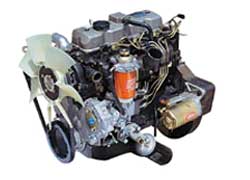 A diesel engine from a Doosan Infracore forklift. |
The US Environmental Protection Agency (EPA) is making USD50 million in grant funding available to establish clean diesel projects to reduce emissions from existing diesel engines.
Authorised by the Energy Policy Act of 2005, the fund will be administered by EPA's National Clean Diesel Campaign (NCDC) and a network of seven collaboratives made up of EPA regional offices and public and private sector partners.
Stephen L Johnson, EPA administrator, says air in the US is cleaner today than a generation ago under the leadership of President George Bush.
"By encouraging innovations in existing diesel engines, EPA is driving the nation toward a clean, healthy and productive tomorrow," says Johnson.
EPA says that if its stringent particulate and nitrogen oxide standards are fully implemented, over 20,000 premature deaths will be avoided and over USD150 billion in public health benefits can be saved.
The funding is aimed at reducing emissions from the existing fleet of 11 million diesel engines that pre-date the standards. "Addressing the existing fleet is important because diesels remain in use for decades," EPA says in a statement.
State, local, regional and tribal governments as well as non-profit organisations and institutions with transportation, educational services and air quality responsibilities can apply for the grants.
EPA is targeting school or transit buses, medium- and heavy-duty trucks, marine engines, locomotives and non-road engines. Grant recipients can use a variety of cost-effective emission reduction strategies like EPA-verified retrofit and idle-reduction technologies, EPA-certified engine upgrades, vehicle or equipment replacements, cleaner fuels and creation of innovative clean diesel financing programs.
NCDC uses an incentive-based approach to achieve environmental results. According to EPA, over 400,000 existing diesel engines have been retrofitted during the campaign's first few years, cutting harmful emissions by nearly 300,000 tons.